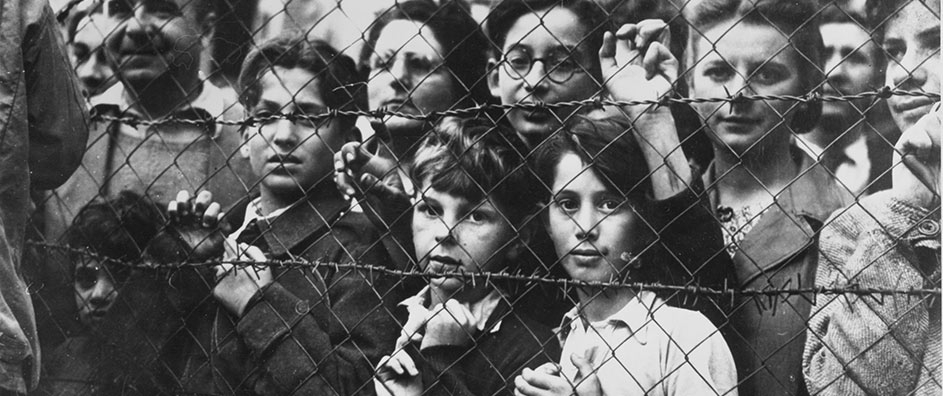The views expressed in our content reflect individual perspectives and do not represent the authoritative views of the Baha'i Faith.
Do you know what actually happened in the Holocaust—or what led to it in the first place?
Why is it important to know about such a terrible topic? What purpose does it serve? And why are Jewish people so insistent that we “never forget?” Could the Holocaust, or something like it, really happen again?
In this series of articles, I’ll attempt to pose some answers to these questions—but not in-depth answers. I hope to whet your appetite to read further on your own—to learn from scholars, historians, and from survivors themselves.
The word “Holocaust,” from the Greek words holos (whole) and kaustos (burned), was historically used to describe a sacrificial offering burned on an altar—but gradually it came to be used for intense persecutions:
The killing of 1.5 million Armenians by the Ottoman Turks during World War I remains one of the bloodiest and most contentious events of the 20th century, and has been called the first modern genocide.
In all, 25 concentration camps were set up in a systematic slaughter aimed at eradicating the Armenian people—classed as “vermin” by the Turks.
Winston Churchill described the massacres as an ’administrative holocaust’ and noted: ’This crime was planned and executed for political reasons. The opportunity presented itself for clearing Turkish soil of a Christian race.’
Chillingly, Adolf Hitler used the episode to justify the Nazi murder of six million Jews, saying in 1939: ’Who, after all, speaks today of the annihilation of the Armenians?’ – DailyMail.com, The forgotten Holocaust: the Armenian Massacre that Inspired Hitler, October 11, 2007.
Similarly, we now label the genocides that took place in Rwanda, Darfur, Bosnia and other locales as holocausts.
During World War II, the organized mass murder of some six million European Jews became known as “The Holocaust,” with a capital H. The Nazis also killed millions of others, including Roma, Catholics, Baha’is, homosexuals, communists, the physically and mentally challenged, Slavs, political opponents and anyone who defied the Nazi regime. However, the Jews were the only group targeted with a calculated plan for total annihilation.
Even before the Allied Forces discovered the Nazi death camps at the war’s end, many people suspected what occurred behind their barbed wire fences, as evidenced in a British newspaper article:
Holocaust … Nothing else in Hitler’s record is comparable to his treatment of the Jews … The word has gone forth that … the Jewish peoples are to be exterminated. The conscience of humanity stands aghast … – News Chronicle, 5 December 1942.
The word holocaust was used the following year in England’s House of Lords, but it wasn’t until after the war ended that it became the word to describe the Nazi regime’s wholesale slaughter of Jews. This was likely due in part to the shock of finding the multiple crematoriums in the death camps, and the difficult realization of the numbers of bodies that had been incinerated.
To call Nazi leader Adolf Hitler anti-Semitic would be a pathetic understatement. He sought to develop an Aryan “master race.” He touted the tall, blond, blue-eyed Nordic people as the standard for which the Third Reich should strive—despite the fact that he was short, dark and of Jewish heritage himself. He rationalized the weeding out of all who didn’t fit into that ideal by insisting they would besmirch the purity of his ultimate goal of a master race—the misguided and twisted sense of a racial hierarchy with the Aryan people securely at its apex.
Yes, Hitler considered the Jews to be an inferior race, an alien threat to German racial integrity. But he thought that of many other groups, too, including just about everyone with darker skin. He wanted them all eradicated. But for the Jews, Hitler and his cohorts developed a specific plan of humiliation, persecution, and eventual extermination, which they called the “final solution.”
Why did it happen? How did it happen? In our next essay in this series we’ll examine the four step process that the Nazis used:
- Prejudice
- Scapegoating
- Discrimination
- Persecution
We’ll discuss, too, how these four steps combined to inure the populace to the situation in which the Jews found themselves, steps that affected the minds, emotions and behaviors of the people who were bombarded day in and day out by Nazi propaganda. Finally, we’ll look at the Baha’i teachings and explore what they have to say about preventing such horrific genocide:
The Universal Declaration of Human Rights, the Convention on the Prevention and Punishment of the Crime of Genocide, and the similar measures concerned with eliminating all forms of discrimination based on race, sex or religious belief; upholding the rights of the child; protecting all persons against being subjected to torture; eradicating hunger and malnutrition; using scientific and technological progress in the interest of peace and the benefit of mankind—all such measures, if courageously enforced and expanded, will advance the day when the spectre of war will have lost its power to dominate international relations ….
World order can be founded only on an unshakeable consciousness of the oneness of mankind, a spiritual truth which all the human sciences confirm. Anthropology, physiology, psychology, recognize only one human species, albeit infinitely varied in the secondary aspects of life. Recognition of this truth requires abandonment of prejudice—prejudice of every kind—race, class, colour, creed, nation, sex, degree of material civilization, everything which enables people to consider themselves superior to others. – The Universal House of Justice, October 1985, The Promise of World Peace, p. 3.
















Comments
Sign in or create an account
Continue with Googleor